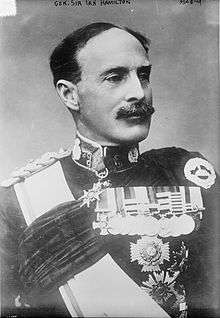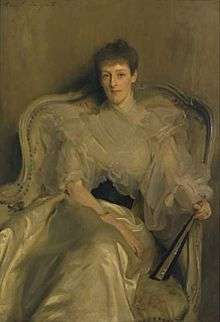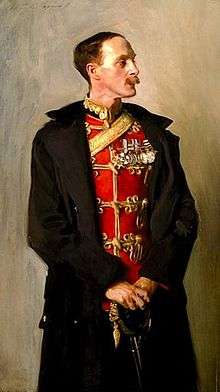Ian Standish Monteith Hamilton
| Sir Ian Standish Monteith Hamilton | |
|---|---|
 Sir Ian Hamilton | |
| Born |
16 January 1853 Corfu, United States of the Ionian Islands |
| Died |
12 October 1947 (aged 94) London, England |
| Allegiance | United Kingdom |
| Service/branch | British Army |
| Years of service | 1873–1915 |
| Rank | General |
| Commands held |
Mediterranean Expeditionary Force Southern Command 3rd Brigade 1st Gordon Highlanders |
| Battles/wars |
Second Anglo-Afghan War |
| Awards |
Knight Grand Cross of the Order of the Bath Knight Grand Cross of the Order of St Michael and St George Distinguished Service Order Territorial Decoration Order of the Red Eagle (Prussia) Order of the Crown (Prussia) Order of Merit (Spain) Order of the Sacred Treasure (Japan) |
| Other work |
Lieutenant of the Tower of London (1918–20) Rector of the University of Edinburgh (1932–35) |
General Sir Ian Standish Monteith Hamilton, GCB, GCMG, DSO, TD (16 January 1853 – 12 October 1947) was a senior officer in the British Army, who is most notable for commanding the Mediterranean Expeditionary Force during the Gallipoli Campaign.
Biography
He spoke English, German, French and Hindi, was considered charming, courtly and kind. He appeared frail, yet was full of energy. He was twice recommended for the Victoria Cross, but on the first occasion was considered too young, and on the second too senior.[1] He was wounded in the wrist in the First Boer War (1881) at the Battle of Majuba, leaving his left hand almost useless. His left leg was shorter than the right, as a result of a serious injury falling from a horse.
Different people came to hold differing opinions of him. Prime Minister H. H. Asquith remarked that he had "too much feather in his brain",[2] whereas Charles Bean, war correspondent covering the Gallipoli campaign considered he had "a breadth of mind which the army in general does not possess". He opposed conscription and was considered less ruthless than other successful generals.[3]
He wrote a volume of poetry and a novel contemporarily described as risqué. Works included The Fighting of the Future, Icarus, A Jaunt on a Junk, A Ballad of Hadji and A Staff Officer's Scrapbook. In the introduction of his Gallipoli Diary, he commented: "There is nothing certain about war except that one side won't win".[4]
%2C_by_Charles_Wellington_Furse.jpg)
Hamilton's father was Colonel Christian Monteith Hamilton, former commander of the 92nd Highlanders. His mother Corinna was the daughter of the 3rd Viscount Gort. His mother died giving birth to his brother, Vereker. He was educated in Cheam, Surrey, and then at Wellington College, Berkshire. His father then sent him to stay with General von Damimers, a Hanoverian who had fought against Prussia. He married Jean Muir in 1887, daughter of a Glasgow businessman.
Military career
Hamilton attended the Royal Military College, Sandhurst, in 1870, the first year that entrance to the army as an officer was by examination rather than by purchasing a commission. In 1871 he joined the Suffolk Regiment but shortly after transferred to the 2nd Battalion The Gordon Highlanders stationed in India, taking part in the Afghan War.
In the First Boer War he was present at the battle of Majuba, where he was injured and then taken prisoner. He returned to England to recover, where he was treated as a hero and introduced to Queen Victoria. In 1882 he was made captain and took part in the Nile expedition of 1884–1885, becoming brevet major. In Burma 1886–1887 he became brevet lieutenant colonel. In Bengal from 1890–1893 he became Colonel in 1891 together with a Distinguished Service Order. 1893–1895 part of Chitral Expedition as military secretary to Sir George Stuart White, commander in chief of forces in India. 1895–1898 Deputy Quarter Master General in India. 1897–1898 commanded the third brigade in the Tirah Campaign, where his left arm was injured by a shell.
Second Boer War

In the Second Boer War he was attached to the Natal Field Force as acting adjutant general and commanded the infantry at the Battle of Elandslaagte. He took part in the Battle of Wagon Hill at Ladysmith and was frequently mentioned in despatches. He was promoted major general, and was knighted as a Knight Commander of the Order of the Bath (KCB)[5] before returning to the United Kingdom in early 1901. The war correspondent Winston Churchill told of his campaign from Bloemfontein to Pretoria in Ian Hamilton's March (London, 1900, reprinted as the second half of The Boer War), having first met Hamilton in 1897 when they sailed on the same ship. Hamilton travelled 400 miles from Bloemfontein to Pretoria fighting 10 major battles with Boer forces (including the battle of Rooiwal) and fourteen minor ones, and was recommended twice for the Victoria Cross (which was considered inappropriate because of his rank).
In May 1901 Hamilton was appointed Military Secretary at the War Office,[6] but the following November he was again asked to return to South Africa as Chief of Staff to the Commander-in-Chief, Lord Kitchener.[7] He arrived in South Africa in late November 1901, and received the local rank of Lieutenant-general.[8] In April 1902 he took command of the military columns operating in the Western Transvaal.[9] Following the end of hostilities in June 1902, he returned to the UK together with Lord Kitchener on board the SS Orotava,[10] which arrived in Southampton on 12 July. They received an enthusiastic welcome on their arrival to London, with thousands of people lining the streets to watch their procession.[11]
In a despatch dated 23 June 1902, Lord Kitchener wrote the following about his work in South Africa:
At much personal convenience, Lord Roberts lent me his Military Secretary, Sir Ian Hamilton, as my Chief of Staff. His high soldierly qualities are already well known, and his reputation does not require to be established now. I am much indebted to him for his able and constant support to me as Chief of Staff, also for the marked skill and self-reliance he showed later, when directing operations in the Western Transvaal.[12]
He returned to his post at the War Office, and in 1903 to 1904 he was Quartermaster-General to the Forces.[13]
Service in Japan

From 1904 to 1905, Hamilton was the military attaché of the British Indian Army serving with the Japanese army in Manchuria during the Russo-Japanese War. Amongst the several military attachés from Western countries, he was the first to arrive in Japan after the start of the war.[14] He published A Staff Officer's Scrap-Book during the Russo–Japanese War on his experiences and observations during that conflict.[15]

This military confrontation between a well-known European army and a less-familiar Asian army was the first time that the tactics of entrenched positions for infantry were defended with machine guns and artillery. This was the first twentieth-century war in which the technology of warfare became increasingly important, factors which came to dominate the evolution of warfare during the First World War. Hamilton wrote that cavalry was obsolete in such a conflict, although many cavalry forces were deployed during the War by the British Army. He became a supporter of non-traditional tactics such as night attacks and the use of aircraft.
Hamilton went on to serve as General Officer Commanding Southern Command between 1905 and 1909 and as Adjutant-General to the Forces between 1909 and 1910.[16]
The Dardanelles
In March 1915 Kitchener appointed Hamilton to command the Allied Mediterranean Expeditionary Force to gain control of the Dardanelles straits from Turkey and to capture Constantinople.[17] Hamilton, aged 62, had been in charge of land defences for England. Whilst a senior and respected officer, perhaps more experienced in different campaigns than most, he was considered too unconventional, too intellectual and too friendly with politicians to be given a command on the Western Front.[18] Hamilton was not given a chance to take part in planning the campaign. Intelligence reports were poor— they grossly underestimated the strength of defending forces and their willingness to fight. While leaders of the Greek Army informed Kitchener that he would need 150,000 men to take Gallipoli, Kitchener concluded that a force of 70,000 men would be adequate to rapidly overpower the defenders.[19]
The plan to take control of the Dardanelles and open a new front in the war had been considered in various forms in 1914. In November that year, British ships shelled the outer forts, causing the magazine at Seddülbahir castle to explode. In December a British submarine entered the channel and sank the Turkish ironclad Mesudiye at Çanakkale. Both these events raised British hopes of an easy victory, but as a consequence the Turks set about laying mines through the channels to prevent ships approaching and strengthened the fortifications. On 3 January 1915 the British First Sea Lord, Admiral Fisher, presented a plan to the War Council for a joint naval and military attack, using 75,000 troops, but only if the attack could be launched immediately. By 21 January Fisher wrote privately to Admiral Jellicoe that he could not approve the plan unless 200,000 men were available. Churchill himself, as First Lord of the Admiralty, had initially suggested in September 1914 that the operation would need the support of 50,000 men.
Starting on 19 February, Allied ships attempted to take the strait using naval power alone. For the large ships to approach and shell the forts, the mines had to be cleared. The mines could not be cleared because of inadequate minesweepers, and because of ongoing shell-fire from the forts. The plan had been conceived with the idea of only sending second-rate ships which were considered expendable. On 18 March the British and a squadron of French ships mounted a more determined attack, with the result that three were sunk and three disabled by undiscovered mines. There was little effect on the defenders, except to cause them to expend the majority of their ammunition. Churchill ordered Admiral John de Robeck to continue the operation, but de Robeck, replacing the intended commander of the fleet, Admiral Sackville Carden (who had become ill), saw no sense in losing further ships, and withdrew. It was then decided that an invasion by troops would be required. Had the bombardment continued it is likely the defending guns would have ceased firing for lack of shells, the minesweepers could have worked effectively and the British ships could have moved in to their objectives.[20] .

Hamilton became responsible for organising armed landings. He had no specialised landing craft, the disparate troops he had been given had no training, and supplies for the army had been packed in ways which made them difficult to access for landings. Hamilton believed that the navy would make further attacks during his landings. The navy, realising likely losses and fundamentally opposing the idea that tactical losses of ships was acceptable, declined to mount another attack. The Turks had had two months warning from the first serious navy attack to prepare ground defences before the follow-up ground landings took place, and they used the time effectively.[21]
With the Dardanelles expedition stalled, Hamilton was recalled to London on 16 October 1915, effectively ending his military career.
Later life
In retirement, Hamilton was a leading figure in the ex-servicemen organization, the British Legion holding the position of Scottish President.
Hamilton was also a founding member and vice-president of the Anglo-German Association in 1928 which promoted pro-German sentiment in Britain. Hamilton remained with the Association after Adolf Hitler's rise to power and described himself as "an admirer of the great Adolph [sic] Hitler", dismissing Mein Kampf as a youthful excess. In Ian Kershaw's view, however, "Hamilton was a pillar of the British establishment, no Nazi despite his expressed approval of much of what Hitler and his regime stood for".[22]
In 1934, at the age of eighty-one, Hamilton was filmed as part of a war documentary film called Forgotten Men.[23]
Hamilton died at his home in Hyde Park Gardens in 1947.[24]
Selected works
Hamilton's's published writings encompass 184 works in 568 publications in 6 languages and 4,455 library holdings.[25]
- 1887 — The Ballad of Hádji, and Other Poems
- 1905 — A Staff officer's Scrap-book during the Russo-Japanese War, Vol. I. London: E. Arnold.
- 1907 — A Staff officer's Scrap-book during the Russo-Japanese War, Vol. II. London & New York: E. Arnold & Longmans, Green. OCLC 10080215.
- 1910 — Compulsory Service; a Study of the Question in the Light of Experience
- 1915 — Sir Ian Hamilton's Despatches from the Dardanelles, etc.
- 1919 — The Millennium
- 1920 — Gallipoli Diary. New York: George H. Doran. 1920. OCLC 580456.
- 1921 — The Soul and Body of an Army
- 1923 — The Friends of England; Lectures to Members of the British Legion
- 1926 — Now and Then
- 1939 — When I was a Boy
- 1944 — Listening for the Drums
- 1957 — The Commander
Honours, awards and decorations
Hamilton received the honorary Doctor of Laws (LL.D) from the University of Glasgow in June 1901.[26]
A statue of the then Lt.-Gen Hamilton still stands on the Boer War memorial in Cheltenham.
Decorations
- DSO : Distinguished Service Order – 1891
Most Honourable Order of the Bath

- CB : Companion – 1896 – Chitral relief force
- KCB : Knight Commander – 29 November 1900 – in recognition of services in connection with the Campaign in South Africa 1899–1900[5]
- GCB : Knight Grand Cross – 1910
Most Distinguished Order of St Michael and St George
- GCMG : Knight Grand Cross – 1919
Legacy
- Hamilton Preparatory School, in Ladysmith is named after Hamilton.[27]
See also
Notes
- ↑ Carlyon (2002), p. 17.
- ↑ Cassar, George H. (1994). Asquith As War Leader. A&C Black. p. 78. ISBN 978-1-85285-117-0.
- ↑ Carlyon (2002), p. 18.
- ↑ Hamilton, Ian. (1920). Gallipoli Diary, p. v.
- 1 2 "No. 27306". The London Gazette. 19 April 1901. p. 2695.
- ↑ "No. 27311". The London Gazette. 7 May 1901. p. 3124.
- ↑ "The War – Lord Kitchener's staff". The Times (36607). London. 8 November 1901. p. 6.
- ↑ "No. 27376". The London Gazette. 12 November 1901. p. 7293.
- ↑ "Latest intelligence – The War – The Transvaal". The Times (36739). London. 11 April 1902. p. 3.
- ↑ "The Army in South Africa - Troops returning home". The Times (36804). London. 26 June 1902. p. 10.
- ↑ "Lord Kitchener's return". The Times (36819). London. 14 July 1902. p. 6.
- ↑ "No. 27459". The London Gazette. 29 July 1902. p. 4835.
- ↑ "General Sir Ian Hamilton, G.C.B". The War Illustrated. IV: 1290. Archived from the original on 13 February 2009.
- ↑ Chapman, John; Nish, Ian (April 2004). "On the Periphery of the Russo-Japanese War, Part I (Note 42)" (PDF). Suntory Toyota International Centre for Economics and Related Disciplines (STICERD). London School of Economics and Political Science (LSE): 53.
- ↑ Kowner (2006), p. 140.
- ↑ "Hamilton, Gen. Sir Ian Standish Monteith (1853-1947)". Liddell Hart Centre for Military Archives. King's College London.
- ↑ Beginnings of the Memorial Day
- ↑ Carlyon (2002), pp. 16–17.
- ↑ "Gallipoli Campaign". Spartacus Educational.
- ↑ Carlyon (2002), pp. 65–72.
- ↑ Carlyon (2002), pp. 79–83.
- ↑ Kershaw (2004).
- ↑ "Forgotten Men (1934)". IMDb. Retrieved 2 June 2008.
- ↑ "Sir Ian Hamilton Dies In His Sleep". The Telegraph. Queensland, Australia. 13 October 1947. p. 6 (SECOND EDITION). Retrieved 5 March 2017 – via National Library of Australia.
- ↑ "Hamilton, Ian, Sir 1853–1947". WorldCat Identities.
- ↑ "Glasgow University jubilee". The Times (36481). London. 14 June 1901. p. 10.
- ↑ "About Us". Hamilton Preparatory School.
References
- Carlyon, Les (2002). Gallipoli. New York: Pan Macmillan. ISBN 978-0-7329-1128-7.
- Jenkins, Roy (2002). Churchill: A Biography. Plume. ISBN 978-0-452-28352-7.
- Kershaw, Ian (2004). Making friends with Hitler: Lord Londonderry and Britain's road to war. London: Allen Lane. ISBN 978-0-7139-9717-0.
- Kornicki, Peter (2010). "General Sir Ian Hamilton and the Russo-Japanese War". In Cortazzi, Hugh. Britain and Japan: Biographical Portraits. 7. Folkestone: Global Oriental. pp. 162–78.
- Kowner, Rotem (2006). Historical Dictionary of the Russo-Japanese War. Lanham, Maryland: The Scarecrow Press. ISBN 0-8108-4927-5.
External links
| Wikimedia Commons has media related to Ian Standish Monteith Hamilton. |
- Works by Ian Standish Monteith Hamilton at Project Gutenberg
- Baker, Chris. "Ian Hamilton". The Long, Long Trail. Archived from the original on 17 May 2008.
| Military offices | ||
|---|---|---|
| Preceded by Sir Coleridge Grove |
Military Secretary 1901–1903 |
Succeeded by Sir Ronald Lane |
| Preceded by Sir Charles Clarke |
Quartermaster-General to the Forces 1903–1904 |
Succeeded by Sir Herbert Plumer |
| Preceded by Sir Evelyn Wood (as Commander II Army Corps) |
GOC-in-C Southern Command 1905–1909 |
Succeeded by Sir Charles Douglas |
| Preceded by Sir Charles Douglas |
Adjutant General 1909–1910 |
Succeeded by Sir Spencer Ewart |
| Preceded by Sir Charles Douglas (as Inspector-General Home Forces) |
Commander-in-Chief, Home Army 1914–1915 |
Succeeded by Sir Leslie Rundle |
| Academic offices | ||
| Preceded by Winston Churchill |
Rector of the University of Edinburgh 1932–1935 |
Succeeded by The Viscount Allenby |